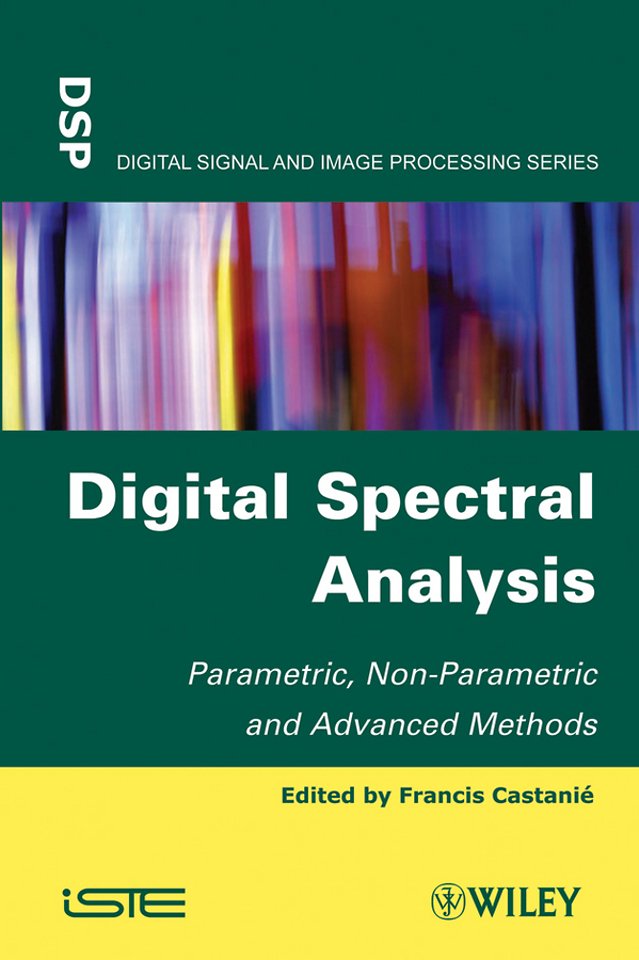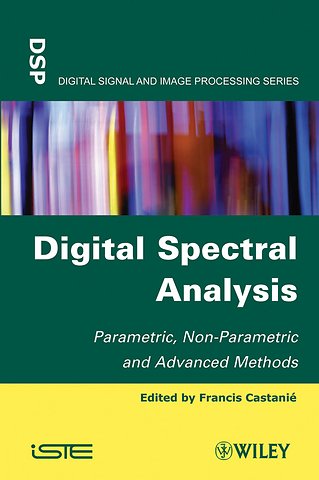Digital Spectral Analysis – Parametric, Non–parametic and Advanced Methods
Parametric, Non–Parametric and Advanced Methods
Gebonden Engels 2011 9781848212770Samenvatting
Digital Spectral Analysis provides a single source that offers complete coverage of the spectral analysis domain. This self–contained work includes details on advanced topics that are usually presented in scattered sources throughout the literature.
The theoretical principles necessary for the understanding of spectral analysis are discussed in the first four chapters: fundamentals, digital signal processing, estimation in spectral analysis, and time–series models.
An entire chapter is devoted to the non–parametric methods most widely used in industry.
High resolution methods are detailed in a further four chapters: spectral analysis by stationary time series modeling, minimum variance, and subspace–based estimators.
Finally, advanced concepts are the core of the last four chapters: spectral analysis of non–stationary random signals, space time adaptive processing: irregularly sampled data processing, particle filtering and tracking of varying sinusoids.
Suitable for students, engineers working in industry, and academics at any level, this book provides a rare complete overview of the spectral analysis domain.
Specificaties
Lezersrecensies
Inhoudsopgave
<p>PART 1. TOOLS AND SPECTRAL ANALYSIS 1</p>
<p>Chapter 1. Fundamentals 3<br /> Francis CASTANIÉ</p>
<p>1.1. Classes of signals 3</p>
<p>1.2. Representations of signals 9</p>
<p>1.3. Spectral analysis: position of the problem 20</p>
<p>1.4. Bibliography 21</p>
<p>Chapter 2. Digital Signal Processing 23<br /> Éric LE CARPENTIER</p>
<p>2.1. Introduction 23</p>
<p>2.2. Transform properties 24</p>
<p>2.3. Windows 49</p>
<p>2.4. Examples of application 57</p>
<p>2.5. Bibliography 64</p>
<p>Chapter 3. Introduction to Estimation Theory with Application in Spectral Analysis 67<br /> Olivier BESSON and André FERRARI</p>
<p>3.1. Introduction 67</p>
<p>3.2. Covariance–based estimation 86</p>
<p>3.3. Performance assessment of some spectral estimators 95</p>
<p>3.4. Bibliography 102</p>
<p>Chapter 4. Time–Series Models 105<br /> Francis CASTANIÉ</p>
<p>4.1. Introduction 105</p>
<p>4.2. Linear models 107</p>
<p>4.3. Exponential models 117</p>
<p>4.4. Nonlinear models 120</p>
<p>4.5. Bibliography 121</p>
<p>PART 2. NON–PARAMETRIC METHODS 123</p>
<p>Chapter 5. Non–Parametric Methods 125<br /> Éric LE CARPENTIER</p>
<p>5.1. Introduction 125</p>
<p>5.2. Estimation of the power spectral density 130</p>
<p>5.3. Generalization to higher–order spectra 141</p>
<p>5.4. Bibliography 142</p>
<p>PART 3. PARAMETRIC METHODS 143</p>
<p>Chapter 6. Spectral Analysis by Parametric Modeling145<br /> Corinne MAILHES and Francis CASTANIÉ</p>
<p>6.1. Which kind of parametric models? 145</p>
<p>6.2. AR modeling 146</p>
<p>6.3. ARMA modeling 154</p>
<p>6.4. Prony modeling 156</p>
<p>6.5. Order selection criteria 158</p>
<p>6.6. Examples of spectral analysis using parametric modeling 162</p>
<p>6.7. Bibliography 166</p>
<p>Chapter 7. Minimum Variance 169<br /> Nadine MARTIN</p>
<p>7.1. Principle of the MV method . . 174</p>
<p>7.2. Properties of the MV estimator 177</p>
<p>7.3. Link with the Fourier estimators 188</p>
<p>7.4. Link with a maximum likelihood estimator 190</p>
<p>7.5. Lagunas methods: normalized MV and generalized MV 192</p>
<p>7.6. A new estimator: the CAPNORM estimator 200</p>
<p>7.7. Bibliography 204</p>
<p>Chapter 8. Subspace–Based Estimators and Application to Partially Known Signal Subspaces 207<br /> Sylvie MARCOS and Rémy BOYER</p>
<p>8.1. Model, concept of subspace, definition of high resolution 207</p>
<p>8.2. MUSIC 211</p>
<p>8.3. Determination criteria of the number of complex sine waves 216</p>
<p>8.4. The MinNorm method 217</p>
<p>8.5. Linear subspace methods 219</p>
<p>8.6. The ESPRIT method 223</p>
<p>8.7. Illustration of the subspace–based methods performance 226</p>
<p>8.8. Adaptive research of subspaces 229</p>
<p>8.9. Integrating a priori known frequencies into the MUSIC criterion. 233</p>
<p>8.10. Bibliography 243</p>
<p>PART 4. ADVANCED CONCEPTS 251</p>
<p>Chapter 9. Multidimensional Harmonic Retrieval: Exact, Asymptotic, and Modified Cramér–Rao Bounds 253<br /> Rémy BOYER</p>
<p>9.1. Introduction 253</p>
<p>9.2. CanDecomp/Parafac decomposition of the multidimensional<br /> harmonic model 255</p>
<p>9.3. CRB for the multidimensional harmonic model 257</p>
<p>9.4. Modified CRB for the multidimensional harmonic model 266</p>
<p>9.5. Conclusion 272</p>
<p>9.6. Appendices 273</p>
<p>9.7. Bibliography 284</p>
<p>Chapter 10. Introduction to Spectral Analysis of Non–Stationary Random Signals 287<br /> Corinne MAILHES and Francis CASTANIÉ</p>
<p>10.1. Evolutive spectra 288</p>
<p>10.2. Non–parametric spectral estimation 290</p>
<p>10.3. Parametric spectral estimation 291</p>
<p>10.4. Bibliography 297</p>
<p>Chapter 11. Spectral Analysis of Non–uniformly Sampled Signals 301<br /> Arnaud RIVOIRA and Gilles FLEURY</p>
<p>11.1. Applicative context 301</p>
<p>11.2. Theoretical framework 302</p>
<p>11.3. Generation of a randomly sampled stochastic process 302</p>
<p>11.4. Spectral analysis using undated samples 305</p>
<p>11.5. Spectral analysis using dated samples 309</p>
<p>11.6. Perspectives 314</p>
<p>11.7. Bibliography 315</p>
<p>Chapter 12. Space Time Adaptive Processing 317<br /> Laurent SAVY and François LE CHEVALIER</p>
<p>12.1. STAP, spectral analysis, and radar signal processing 319</p>
<p>12.2. Space time processing as a spectral estimation problem 327</p>
<p>12.3. STAP architectures 334</p>
<p>12.4. Relative advantages of pre–Doppler and post–Doppler STAP 354</p>
<p>12.5. Conclusion 358</p>
<p>12.6. Bibliography 359</p>
<p>12.7. Glossary 360</p>
<p>Chapter 13. Particle Filtering and Tracking of Varying Sinusoids 361<br /> David BONACCI</p>
<p>13.1. Particle filtering 361</p>
<p>13.2. Application to spectral analysis 370</p>
<p>13.3. Bibliography 375</p>
<p>List of Authors 377</p>
<p>Index 379</p>
Rubrieken
- advisering
- algemeen management
- coaching en trainen
- communicatie en media
- economie
- financieel management
- inkoop en logistiek
- internet en social media
- it-management / ict
- juridisch
- leiderschap
- marketing
- mens en maatschappij
- non-profit
- ondernemen
- organisatiekunde
- personal finance
- personeelsmanagement
- persoonlijke effectiviteit
- projectmanagement
- psychologie
- reclame en verkoop
- strategisch management
- verandermanagement
- werk en loopbaan

